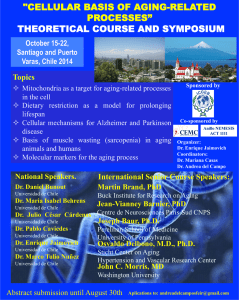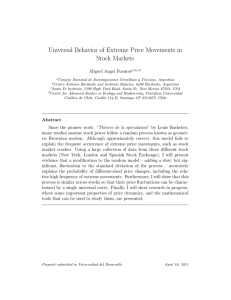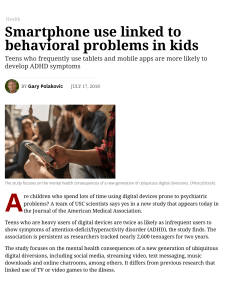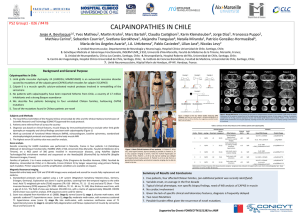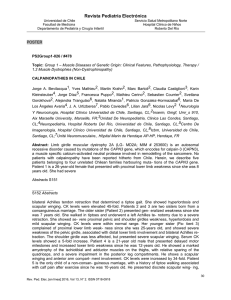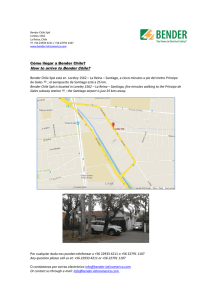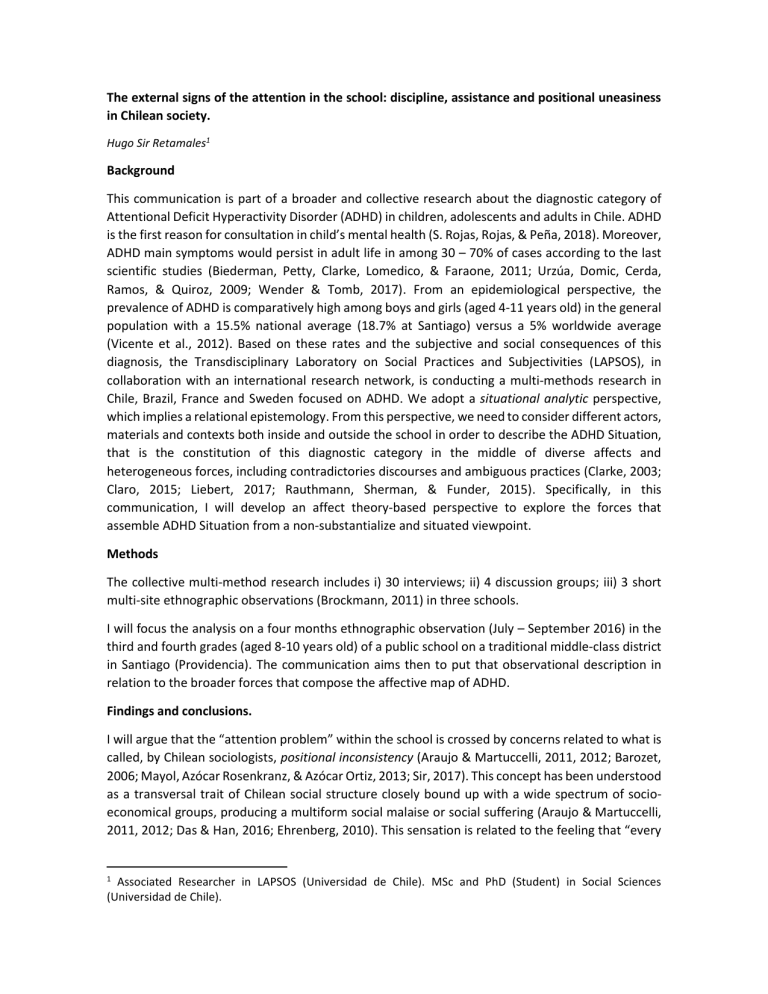
The external signs of the attention in the school: discipline, assistance and positional uneasiness in Chilean society. Hugo Sir Retamales1 Background This communication is part of a broader and collective research about the diagnostic category of Attentional Deficit Hyperactivity Disorder (ADHD) in children, adolescents and adults in Chile. ADHD is the first reason for consultation in child’s mental health (S. Rojas, Rojas, & Peña, 2018). Moreover, ADHD main symptoms would persist in adult life in among 30 – 70% of cases according to the last scientific studies (Biederman, Petty, Clarke, Lomedico, & Faraone, 2011; Urzúa, Domic, Cerda, Ramos, & Quiroz, 2009; Wender & Tomb, 2017). From an epidemiological perspective, the prevalence of ADHD is comparatively high among boys and girls (aged 4-11 years old) in the general population with a 15.5% national average (18.7% at Santiago) versus a 5% worldwide average (Vicente et al., 2012). Based on these rates and the subjective and social consequences of this diagnosis, the Transdisciplinary Laboratory on Social Practices and Subjectivities (LAPSOS), in collaboration with an international research network, is conducting a multi-methods research in Chile, Brazil, France and Sweden focused on ADHD. We adopt a situational analytic perspective, which implies a relational epistemology. From this perspective, we need to consider different actors, materials and contexts both inside and outside the school in order to describe the ADHD Situation, that is the constitution of this diagnostic category in the middle of diverse affects and heterogeneous forces, including contradictories discourses and ambiguous practices (Clarke, 2003; Claro, 2015; Liebert, 2017; Rauthmann, Sherman, & Funder, 2015). Specifically, in this communication, I will develop an affect theory-based perspective to explore the forces that assemble ADHD Situation from a non-substantialize and situated viewpoint. Methods The collective multi-method research includes i) 30 interviews; ii) 4 discussion groups; iii) 3 short multi-site ethnographic observations (Brockmann, 2011) in three schools. I will focus the analysis on a four months ethnographic observation (July – September 2016) in the third and fourth grades (aged 8-10 years old) of a public school on a traditional middle-class district in Santiago (Providencia). The communication aims then to put that observational description in relation to the broader forces that compose the affective map of ADHD. Findings and conclusions. I will argue that the “attention problem” within the school is crossed by concerns related to what is called, by Chilean sociologists, positional inconsistency (Araujo & Martuccelli, 2011, 2012; Barozet, 2006; Mayol, Azócar Rosenkranz, & Azócar Ortiz, 2013; Sir, 2017). This concept has been understood as a transversal trait of Chilean social structure closely bound up with a wide spectrum of socioeconomical groups, producing a multiform social malaise or social suffering (Araujo & Martuccelli, 2011, 2012; Das & Han, 2016; Ehrenberg, 2010). This sensation is related to the feeling that “every 1 Associated Researcher in LAPSOS (Universidad de Chile). MSc and PhD (Student) in Social Sciences (Universidad de Chile). social position may suffer active processes of destabilization due to the transference to individuals of the tasks related to the level and quality of their social integration (…) It is a permanent positional concern, an everyday attitude of uneasiness which is a reflection of a society traversed by plural feelings of instability”(Araujo & Martuccelli, 2011, p. 168). I will describe in the first section the main forces that compose the situational analytic of ADHD in Chile. I will show the importance of the neoliberal exigencies upon Chilean school, families and teachers. Requirements transferred to children via the emphasis on performance and obedience. Second, I will explore the rearrangement of traditional Chilean classroom associated with the presence of the School Integration Program (PIE, Spanish initials). The observation of the PIE device inside the four classrooms of 3rd and 4th grades, allows highlighting the coating and displacement of the punishment (disciplinary technology) by the assistance (governmental or securitarian technology) (Castro-Gómez, 2015; Foucault, 2006, 2007). Third, I will show how this produces the ADHD Situation via the requirement of the external signs of attention above others forms of attentional verification. This modality of obedience would not be related to standardized evaluation school performance criteria only (Bergey et al, 2018), but it involves modes of being in the Spinozian sense, which means qualitative differences between ways of living (Deleuze, 2008). Even, new approaches to ADHD, will insist about the anthropological variation between individuals with and without what is called as a ADHD brain (Aboitiz & Carrasco, 2009; Aboitiz, López, López-Calderon, & Carrasco, 2006). This is closely linked with what Rose (2007) named as ethopolitics, to refer to attempts to “shape the conduct of human beings by acting upon their sentiments, beliefs, and values—in short, by acting on ethics (…) the ethos of human existence—the sentiments, moral nature, or guiding beliefs of persons, groups, or institutions—has come to provide the “medium” within which the self-government of the autonomous individual can be connected up with the imperatives of good government” (Rose, 2007, p. 27) In that sense, the unfolding of the PIE device and the production of the ADHD Situation itself, operates the ethic translation of a civilizing moral principle, understood as the obligatory internalization of the authority and control (Elias, 2010). Then, is not only matter to obey or internalize because authority said it, instead of it, is about to adopt the symbol to be a right kind of human being, which implies showing the external signs of attention, because it is good. Finally, as a conclusion, I will underline the high elective affinity between the production of the obedience of attentional external signs and the generalized positional uneasiness, which is one of the most remarkable characteristics of the Chilean society under its neoliberal constitution: good means the possibility to scape of the always haunting possibility to be poor, then the dimensions of obligation and decision are essentially indistinct. References Aboitiz, F., & Carrasco, X. (Eds.). (2009). Déficit atencional e hiperactividad: Fronteras y desafíos. Santiago de Chile: Ediciones UC. Aboitiz, F., López, V., López-Calderon, J., & Carrasco, X. (2006). Beyond endophenotypes: An interdisciplinary approach to attentional deficit-hieractivity-disorder. In M. A. Vanchevsky (Ed.), Focus on cognitive psychology research (pp. 183–205). New York: Nova Science Publishers. Araujo, K., & Martuccelli, D. (2011). La inconsistencia posicional: Un nuevo concepto sobre la estratificación social. CEPAL. (103), 165–178. Araujo, K., & Martuccelli, D. (2012). Desafíos comunes: Retrato de la sociedad chilena y sus individuos (1a. ed.). Ciencias humanas. Sociología. Santiago: LOM Ediciones. Barozet, E. (2006). El valor histórico del pituto: clase media, integración y diferenciación social en Chile. Revista De Sociología De La Universidad De Chile. (20), 69–96. Biederman, J., Petty, C. R., Clarke, A., Lomedico, A., & Faraone, S. V. (2011). Predictors of Persistent ADHD: An 11-year Follow-up Study. Journal of Psychiatric Research, 45(2), 150–155. https://doi.org/10.1016/j.jpsychires.2010.06.009 Castro-Gómez, S. (2015). Historia de la gubernamentalidad I: Razón de Estado, liberalismo y neoliberalismo en Michel Foucault (Segunda edición). Biblioteca universitaria de ciencias sociales y humanidades. Filosofía política. Bogotá, Colombia: Siglo del Hombre Editores; Pontificia Universidad Javeriana, Instituto Pensar; Ediciones Universidad Santo Tomás de Aquino. Clarke, A. (2003). Situational Analyses: Grounded Theory Mapping After the Postmodern Turn. Symbolic Interaction, 26(4), 553–576. https://doi.org/10.1525/si.2003.26.4.553 Claro, S. (2015). Luche-Mundo: Una metodología para el abordaje responsable y dialógico del TDAH. Estudios Pedagógicos (Valdivia), 41(especial), 31–50. https://doi.org/10.4067/S071807052015000300003 Das, V., & Han, C. (Eds.). (2016). Living and dying in the contemporary world: A compendium. Oakland California: University of California Press. Deleuze, G. (2008). En medio de Spinoza (2da ed.). Clases: Vol. 1. Buenos Aires: Cactus. Ehrenberg, A. (2010). La société du malaise. París: Odile Jacob. Elias, N. (2010). El proceso de la civilización: Investigaciones sociogenéticas y psicogenéticas (3ª ed., 1ª reimp). Sección de obras de sociología. Madrid: Fondo de Cultura Económica de España. Foucault, M. (2006). Seguridad, territorio, población: Curso del Collège de France (1977-1978). Buenos Aires: Fondo de Cultura Económica. Foucault, M. (2007). Nacimiento de la biopolítica: Curso en el Collège de France (1978-1979). Buenos Aires: Fondo de Cultura Económica. Liebert, R. J. (2017). Beside-the-mind: An unsettling, reparative reading of paranoia. Subjectivity, 10(1), 123–145. https://doi.org/10.1057/s41286-016-0015-5 Mayol, A., Azócar Rosenkranz, C., & Azócar Ortiz, C. (2013). El Chile profundo: Modelos culturales de la desigualdad y sus resistencias (1ra edición). Santiago de Chile: Liberalia Ediciones Ltda. Rauthmann, J. F., Sherman, R. A., & Funder, D. C. (2015). Principles of Situation Research: Towards a Better Understanding of Psychological Situations. European Journal of Personality, 29(3), 363– 381. https://doi.org/10.1002/per.1994 Rojas, S., Rojas, P., & Peña, M. (2018). From problematic children to problematic diagnosis: The paradoxical trajcetories of child and adolescent ADHD in Chile. In M. R. Bergey, A. M. Filipe, P. Conrad, & I. Singh (Eds.), Global perspectives on ADHD: Social dimensions of diagnosis and treatment in 16 countries (pp. 310–331). Baltimore: Johns Hopkins University Press. Rose, N. (2007). Politics of life itself: Biomedicine, power, and subjectivity in the twenty-first century. Information series. Princeton: Princeton University Press. Retrieved from http://www.jstor.org/stable/10.2307/j.ctt7rqmf Rose, N. (2012). Políticas de la vida: Biomedicina, poder y subjetividad en el siglo XXI. La Plata: UNIPE. Sir, H. (2017). Más que mérito, esfuerzo: Aproximación crítica al núcleo ético del mercado del trabajo individualizado en Chile. Trabajo Y Sociedad. (29), 307–326. Urzúa, A., Domic, M., Cerda, A., Ramos, M., & Quiroz, J. (2009). Trastorno por déficit de atención con hiperactividad en niños escolarizados. Revista Chilena De Pediatría, 80(4), 332–338. Vicente, B., La Barra, F. de, Saldivia, S., Kohn, R., Rioseco, P., & Melipillan, R. (2012). Prevalence of child and adolescent psychiatric disorders in Santiago, Chile: a community epidemiological study. Social Psychiatry and Psychiatric Epidemiology, 47(7), 1099–1109. https://doi.org/10.1007/s00127-011-0415-3 Wender, P. H., & Tomb, D. A. (2017). ADHD: A guide to understanding symptoms, causes, diagnosis, treatment, and changes over time in children, adolescents, and adults (Fifth edition). New York NY: Oxford University Press.




